Building Envelope Case Study

By: Mike Stellato, AIA, LEED AP, CSI, NCARB Certified, Principal - Star Consulting Group
What is now considered “common knowledge” is most often learned from mistakes of the past. For example, it is now considered standard practice of the industry to have an air barrier around all six sides of a building envelope. Not too long ago this was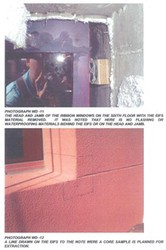 the exception rather than the rule. And before that, very little emphasis was put on keeping air and moisture from entering the building envelope, which leaves most buildings that are in use today vulnerable to the effects of air and moisture infiltration in the form of water leaks and energy inefficiencies. The results of which can be massive problems not only for the buildings, but also for the occupants. Discovering the causes of these problems takes intimate knowledge of the materials and the construction process of the buildings themselves.
the exception rather than the rule. And before that, very little emphasis was put on keeping air and moisture from entering the building envelope, which leaves most buildings that are in use today vulnerable to the effects of air and moisture infiltration in the form of water leaks and energy inefficiencies. The results of which can be massive problems not only for the buildings, but also for the occupants. Discovering the causes of these problems takes intimate knowledge of the materials and the construction process of the buildings themselves.
Sometimes buildings do not perform to the purpose for which they are designed. This can be a matter of function with the design of spaces and also the design of the building envelope. In the case of a building envelope, many factors can and do influence the design and construction of the building skeletal shell and exterior skin. Such factors may include budget, value engineering, construction method, time constraints, season, location and environmental influences. These factors may influence the actual materials used and the methods of installation. Sometimes evidence of failure occurs before completion of the project; sometimes many years later. However, in all cases where building envelopes fail, the results are damage to the building and dissatisfaction of the user. With building envelopes, it can be water leaks, moisture laden cold walls, high utility bills and inefficient HVAC functions related to the failure of insulation in roofs or walls.
Such was the case of a 15-year-old high profile municipal building with multiple failures of the roof and exterior skin. Investigation and destructive testing proved that there was massive failure of the roof surfaces with wet insulation caused by roof coping a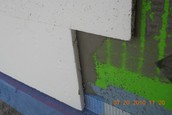 nd roof drain failures. Wall surfaces of this building were covered by an EIFS system. The EIFS was performing to its designed limits, but was installed incorrectly without a drainage plane or flashing. Building movement cracked control joints and the EIFS itself. Age deteriorated sealants, which were not maintained or renewed, and allowed substantial water infiltration into the wall system. The building was a concrete frame with some punched openings for windows and some stud wall infill.
nd roof drain failures. Wall surfaces of this building were covered by an EIFS system. The EIFS was performing to its designed limits, but was installed incorrectly without a drainage plane or flashing. Building movement cracked control joints and the EIFS itself. Age deteriorated sealants, which were not maintained or renewed, and allowed substantial water infiltration into the wall system. The building was a concrete frame with some punched openings for windows and some stud wall infill.
A number of investigative techniques were used to assess the condition of the envelope condition including thermography, moisture meters and destructive testing. Destructive testing showed no flashing whatsoever was used anywhere in the building. Not even the sheathing joints were sealed. The EIFS was the only waterproofing! Gaps of two to four inches around the rough openings of windows were common. In most cases the back side of the interior gypsum board could be seen from the exterior. At the areas of stud framing where gypsum sheathing was used on the sills, water leaks had dissolved the gypsum, rusted the studs and plates and infiltrated into the insulation. EIFS was also used at the copings. Maintenance crews did not use the davits and outriggers provided, but hung by ropes over the sides creating massive failure of the EIFS coping edge surfaces, and thus creating entry for water into t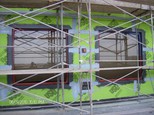 he roof deck and exterior walls.
he roof deck and exterior walls.
One would think this was a ‘slam dunk’ investigation case with an obvious outcome, but this was a very geometrically complicated building with over 450,000 square feet of EIFS exterior wall surface. After much deliberation of the extensive damage and repairs needed and estimation of costs for repair, it was determined that the only course of action for the environmental security of the building was a complete re-skin of EIFS over a new waterproofing barrier and flashing around the windows and on the sheathing. A new roof system was also called for. Research on the existing building was extensive to insure proper detailing of all conditions that would be encountered.
Coordination of system interfacings, flashings and materials was imperative to ensure air and moisture tightness of the exterior envelope. Construction documents were extensive to outline not only the repairs, but the demolition. Dimensional accuracy was imperative or the building’s geometric parts would not align together properl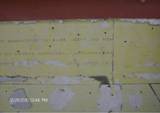 y.
y.
A new roof membrane using an SBS system over tapered insulation was selected on the zero-slope structure because of existing features and flashing points. This also accommodated plaza deck paver areas best without the need for pedestals. Integrating counter flashing in with the EIFS system was critical. Wall to roof metal flashing was installed prior to the EIFS repair and the new drainage plane system. New compressible roof drains were installed that prevented water from entering the new roof insulation layers. Because of past maintenance issues, some of the coping areas were converted from EIFS to colored metal coping with special detailing to eliminate a shadow line.
Wall surfaces took much more planning and detailing. Replacement of the EIFS was sequenced on the building from top to bottom. Once the existing EIFS was removed, the portions of the building that were concrete were smoothed out an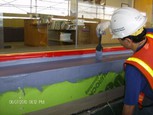 d coated with a cementitious waterproofing compatible with an EIFS drainage plane system. Areas of exposed gypsum sheathing revealed severe delamination and a stratum unsuitable for the re-application of EIFS. Rather than take off the existing gyp sheathing (except in areas of total decomposition), a new layer of gyp sheathing was applied over the existing, eliminating costly waste disposal. This allowed direct attachment to the stud framing and an acceptable substrate for EIFS application that would be warrantable. Continuous weep vents were installed where none had existed between the transition of vertical wall to horizontal EIFS soffits and above window heads. This detailing greatly facilitates the evacuation of moisture from the EIFS drainage plane.
d coated with a cementitious waterproofing compatible with an EIFS drainage plane system. Areas of exposed gypsum sheathing revealed severe delamination and a stratum unsuitable for the re-application of EIFS. Rather than take off the existing gyp sheathing (except in areas of total decomposition), a new layer of gyp sheathing was applied over the existing, eliminating costly waste disposal. This allowed direct attachment to the stud framing and an acceptable substrate for EIFS application that would be warrantable. Continuous weep vents were installed where none had existed between the transition of vertical wall to horizontal EIFS soffits and above window heads. This detailing greatly facilitates the evacuation of moisture from the EIFS drainage plane.
The most difficult part of the wall detailing was the areas around the windows. End dams in the window framing system had totally failed. Water intrusion was so frequent that calcium had built up in the sill framing. For cost and security reasons, the windows were kept in place during this entire process. To close up the huge gaps between the rough opening and the window frames, urethane foam was used to seal the space in the head, jamb and sills of all windows. This filled the open frame members and the oversized RO space and prevented most of the air infiltration from being a problem. Rather than replacing the age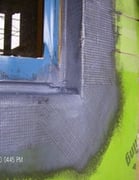 d and shrunken window glazing gaskets, all windows were wet-sealed. Flashing of an existing in-place window can be very tricky. A flexible flashing system was used that would bond to both the substrate and the aluminum window frame. This consisted of a fiber membrane and liquid rubberized flashing compound that would solidify, but remain flexible when dry. This system worked remarkably well and was relatively easy to install; much easier than a peel-n-stick. Visible areas of the window frame were taped off. Several coats of the liquid rubber were required to get full coverage and seal from the system. Drying time was about 12 hours. The cost savings over removal of the windows and frames was priceless.
d and shrunken window glazing gaskets, all windows were wet-sealed. Flashing of an existing in-place window can be very tricky. A flexible flashing system was used that would bond to both the substrate and the aluminum window frame. This consisted of a fiber membrane and liquid rubberized flashing compound that would solidify, but remain flexible when dry. This system worked remarkably well and was relatively easy to install; much easier than a peel-n-stick. Visible areas of the window frame were taped off. Several coats of the liquid rubber were required to get full coverage and seal from the system. Drying time was about 12 hours. The cost savings over removal of the windows and frames was priceless.
Application of the new EIFS exterior wall system was done with a drainage plane system this time. Moisture intrusion into the wall surface can now be mitigated in several ways. First are the acrylic coating and silicone sealants used on the exterior as a first line of defense. Second is the drainage plane system designed to extrude moisture from the wall system with metal flashings above the window openings imbedded behind the EIFS, and thirdly, the waterproof coatings used on the substrate and flashings used around each window’s rough opening will protect the substrate from future damage and keep water from entering around the windows. It is important to note that the manufacturers of the systems used were a critical part of the design process. Mock-u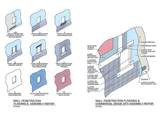 ps were done and water tested. Manufacturer inspections during installation of the roofing and EIFS wall system were welcomed, planned and frequent. This insured that the process was correctly executed and installation would receive the manufacturers’ warranty – an important factor for the municipality owner. This project has been completed for approximately one and one- half years. Inquiries to the users of the building regarding the performance of the systems after significant weather events have all been positive.
ps were done and water tested. Manufacturer inspections during installation of the roofing and EIFS wall system were welcomed, planned and frequent. This insured that the process was correctly executed and installation would receive the manufacturers’ warranty – an important factor for the municipality owner. This project has been completed for approximately one and one- half years. Inquiries to the users of the building regarding the performance of the systems after significant weather events have all been positive.
The important lessons learned on this project are that proper detailing is critical for the integrity of the building envelope and that no ‘value engineering’ (or ‘de-value engineering’) should be accepted that would reduce the effectiveness or integrity of the envelope system. Also, that no matter how bad a building’s envelope may be performing, it is feasible to rectify the situation; however, it may not be financially practical. All of this gives credence to doing things right the first time!
Mike Stellato is a Registered Architect and Principal of Star Consulting Group, having designed High-Rise buildings, Commercial, Industrial, Hospitality, Municipal, K-16 and most every other type of project using most all construction materials & methods of construction for more than 35 years. Associated with Forensic Building Analysis for over 12 years, Mike has provided design assistance and specification development, architectural review and analysis of product applications; contract administration, field inspections and testing; forensic investigation and analysis; and associated services related to new or existing installations of commercial glazing systems (glass curtain walls, skylights, window and doors), Exterior Insulation and Finish Systems (EIFS) and other exterior wall cladding systems, air barrier design, as well as all aspects of waterproofing and related products for walls, roof and foundations.
Mike can be reached at mjstellato@gmail.com or phone 210.887.7469
Subscribe Today!
Stay-in-the-know and subscribe to our blog today!